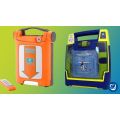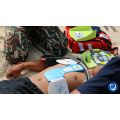Exploring the Different Types of CPR Training
Performing high-quality CPR is an important, life-saving skill that everyone should take the time to learn. An alarming statistic shows that 70% of Americans do not feel comfortable performing CPR because they either don’t know how, or their skill has degraded. It’s critical to keep your skills up-to-date by getting recertified every 2 years, even taking refresher courses every 6 months. This stands in stark contrast to the fact that 88% of cardiac arrests happen outside of the home where bystander CPR is needed.
There are different types of CPR training classes that differ in complexity and skill level, depending on your needs.
Training for Lay-Responders

Lay-responders are extremely important in helping save lives. They are the public, people who have no medical training. However, they are important because they are usually the first people that can respond to a cardiac emergency. It can take minutes for emergency help to arrive, but the chances of surviving a cardiac arrest incident drop by 10% for every minute the victim doesn’t receive help. Lay-responders can save lives if they receive CPR training by helping before emergency rescuers get on the scene.
Heartsaver® Adult and Pediatric First Aid & CPR
The American Heart Association provides specific courses, all under the Heartsaver name, designed specifically for lay rescuers, such as babysitters, fitness trainers, daycare workers, or anyone who wants to learn basic First Aid & CPR. Heartsaver is not meant for aspiring medical professionals who need more advanced CPR, First Aid, AED, and healthcare training.
All courses are offered fully in a classroom or as a blended course (virtual and in-person). Heartsaver is the perfect training for anyone who needs basic CPR, First Aid, or AED instruction.
However, Heartsaver does not stop at adult First Aid & CPR. There are courses for pediatric CPR, adult and pediatric AED training, and even bloodborne pathogen training. Heartsaver Pediatric was developed towards those who work closely with children, such as daycare workers and babysitters. It trains people to respond to illnesses and injuries in a child or infant and keeping them alive until healthcare professionals can take over.
Family & Friends training
The Family & Friends course from AHA allows you to teach all the lifesaving skills necessary for learning how to save a life during a cardiac emergency, including adult and child hands-only CPR and AED use and choking relief from adults, children, and infants. The biggest difference is that these skills are taught in a group environment where skills are taught and learned using the AHA’s research-proven “practice-while-watching technique” that allows students to get the most practice time possible.
Professional Training
It’s important for medical professionals to complete CPR training, even if they aren’t directly involved with airway management or cardiac emergencies. The type of training for each professional depends on the profession and employment needs.
Basic Life Support Training
Basic Life Support training is designed for healthcare professionals or other people who need to know how to perform high-quality CPR and basic life support skills. The training teaches how to recognize a life-threatening emergency, give high-quality chest compressions, proper ventilations using a barrier device, and proper use of an AED.
BLS also encompasses choking-relief training in adults and infants and can be taught to a single rescuer or a team of professionals. For most lay-rescuers, BLS training is excessive. However, for healthcare professionals who need more advanced CPR instruction, BLS may be course for you.
Advanced Cardiovascular Life Support Training
One step above BLS is Advanced Cardiovascular Life Support training. Only healthcare professionals who have completed BLS training and have direct or secondary participation in cardiovascular emergencies, such EMS personnel, need ACLS training. It continues to emphasize the importance of high-quality CPR, while also teaching airway management, use of a bag-mask device, related pharmacology, and recognition of peri-arrest (patients who have survived cardiac arrests or are at greater risk) conditions, like symptomatic bradycardia.
Important Tip: Learn from Accredited CPR Training Centers
Whatever type of CPR training you decide to complete, beware of classes who do not provide hands-on skill training, but still provide certification. Hands-on training, either virtually or in-person, is an essential part of learning CPR. Instructors can teach you what you’re doing wrong, and you get a feel for what it might be like to perform CPR on a real person. A class or instructor who does not provide hands-on training, but still provides certification should be approached with caution. The certificate may be fake or fraudulent.
Stick with accredited CPR training centers from reputable organizations, like the AHA, to stay safe and receive valid certification.
Shop CPR manikins at WorldPoint
WorldPoint wants to acknowledge the brands that make CPR training possible. With over 25 years of experience helping CPR professionals find the best training tools, we know what it takes to save lives. Every CPR manikin is hand-selected, ensuring that all our customers receive the highest-quality CPR training manikins from top brands, such as the Laerdal Little Anne QCPR training manikin.
Have any questions?

Chat with us on our website, www.worldpoint.com. send us an email at customersolutions@worldpoint.com, or give us a call at 866-709-1131. We look forward to answering all your questions!








